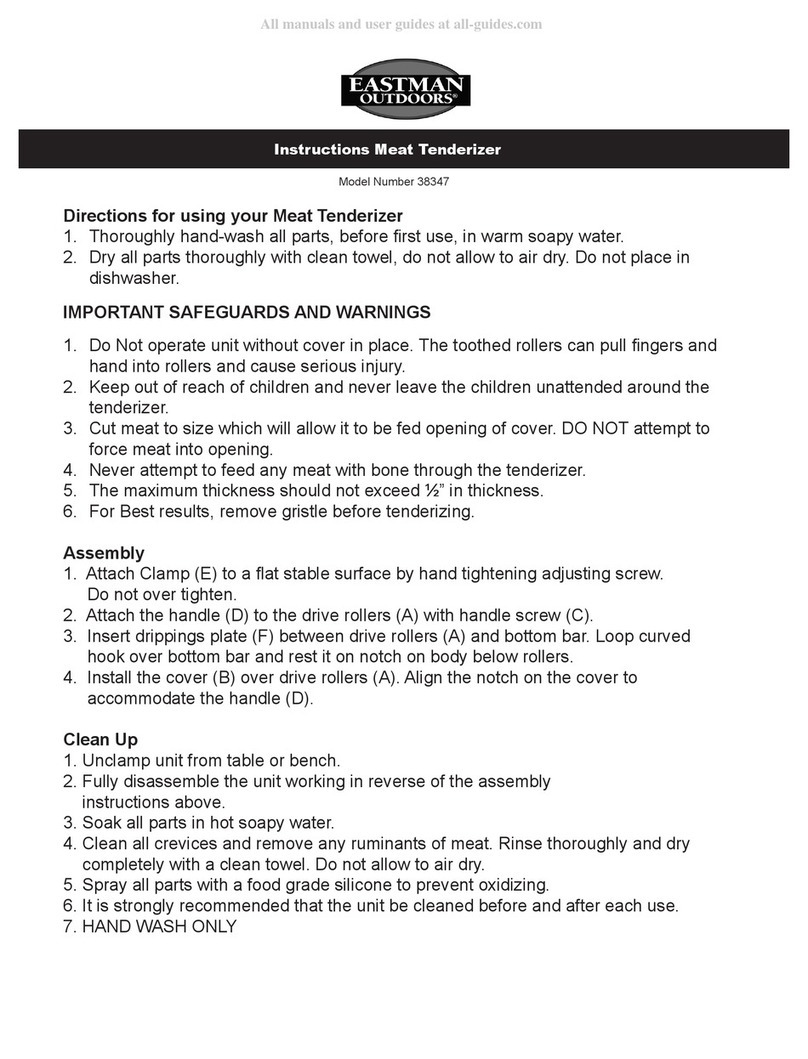
Mises en garde importantes
CONÇU POUR ÊTRE UTILISÉ COMME APPAREIL MÉNAGER À
L'INTÉRIEUR SEULEMENT
Pour éviter des blessures graves ou la mort, un
mauvais fonctionnement ou des dommages à
la propriété, utilisez l’appareil uniquement pour
l’utilisation prévue et suivez toujours les instructions.
Lorsque vous utilisez des appareils électriques, vous devez toujours prendre les
précautions élémentaires incluant ce qui suit :
Lisez toutes les instructions avec soin avant l’utilisation et conservez-les pour
vous y référer dans l’avenir.
1. Faites fonctionner l’appareil uniquement sur une surface plane.
2. Ne touchez pas aux surfaces chaudes. Pour le transport, servez-vous
des poignées ou des boutons. Ne levez jamais l’appareil par le câble
d’alimentation. Utilisez vos deux mains pour tenir les poignées lorsque vous
déplacez l’appareil.
3. Ne laissez pas l’appareil sans surveillance lorsque vous l’utilisez.
4. Ne faites pas fonctionner l’appareil continuellement pendant plus de 40
heures. Après avoir utilisé l’appareil, mettez-le hors tension, débranchez-le
et laissez-le refroidir. Une mauvaise utilisation peut causer des dommages à
l’appareil et possiblement des blessures ou la mort de l’utilisateur.
5. Ne couvrez pas l’appareil durant l’utilisation ou après vous en être servi
jusqu’à ce qu’il soit complètement refroidi.
6. Pour vous protéger contre les chocs électriques, ne plongez pas le câble
d’alimentation, la che ou le boîtier dans l’eau ou un autre liquide.
7. Une étroite surveillance de la part d’un adulte compétent est nécessaire
lorsqu’un appareil est utilisé par des enfants ou près d’enfants.
8. Ne tirez jamais sur le câble pour débrancher l’appareil de la prise électrique.
Saisissez plutôt la che et tirez pour débrancher.
9. Ne faites jamais fonctionner un appareil dont le câble d’alimentation ou la
che est endommagé ou après un mauvais fonctionnement de l’appareil
ou si l’appareil a été endommagé. Si vous croyez que l’appareil a subi des
dommages, retournez-le au centre de réparation agréé le plus près pour
être examiné, réparé ou ajusté.
10. Le boîtier de l’appareil, le câble ou la che ne doivent pas venir en contact
avec de l’eau ou être plongés dans l’eau ou un autre liquide. N’utilisez pas
l’appareil s’il est mouillé ou si vos mains sont mouillées.
11. Avant de brancher l’appareil à la source principale de courant, vériez si
le voltage inscrit sur la plaque signalétique correspond au voltage de votre
maison.
12. L’utilisation d’éléments ajoutés ou d’accessoires qui ne sont pas conseillés
ou vendus par le fabricant de l’appareil peut avoir comme conséquences un
feu, un choc électrique ou des blessures.
13. Débranchez toujours l’appareil de la prise de courant lorsqu’il n’est pas
utilisé, lorsque vous ajoutez ou enlevez des pièces et avant de le nettoyer.
Laissez-le refroidir avant d’ajouter ou d’enlever des pièces.
14. Ne laissez pas le câble d’alimentation pendre sur le bord d’une surface de
travail ou toucher les surfaces chaudes.
15. Ne placez pas l’appareil sur ou près d’un brûleur à gaz ou électrique chaud
2
AVERTISSEMENT










































